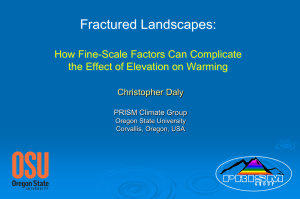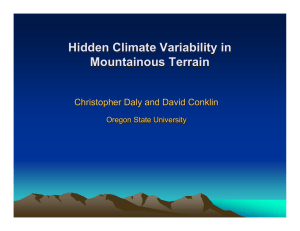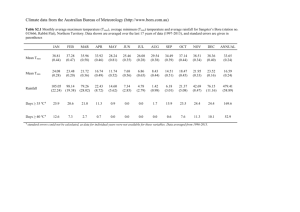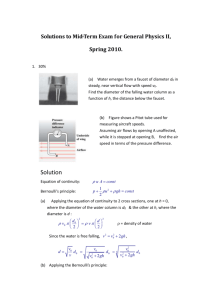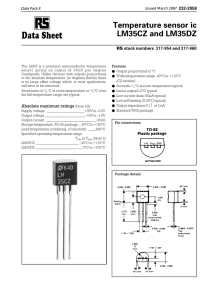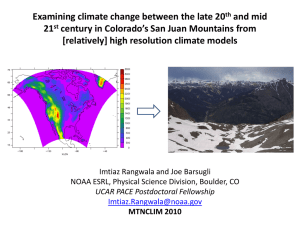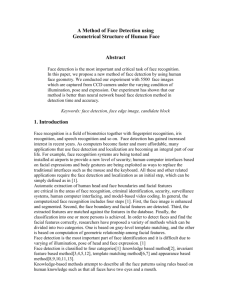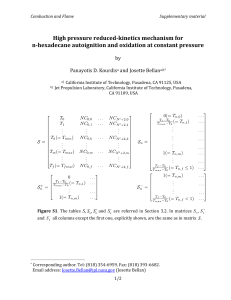Climate change uncertainty for daily minimum and maximum
advertisement
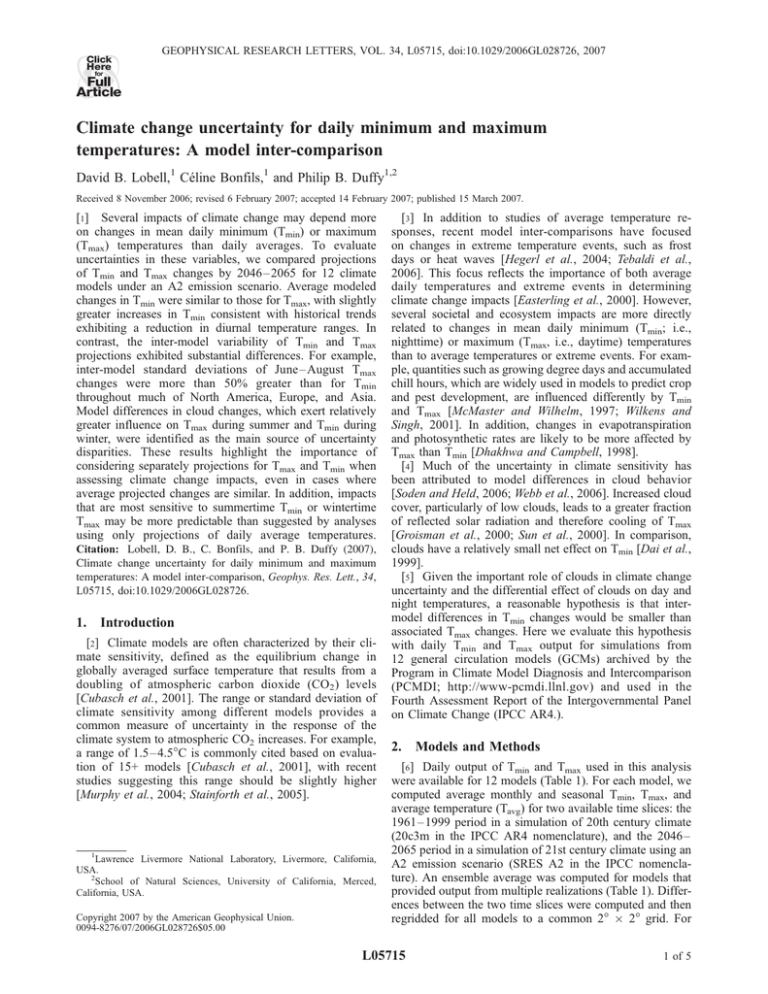
Click Here GEOPHYSICAL RESEARCH LETTERS, VOL. 34, L05715, doi:10.1029/2006GL028726, 2007 for Full Article Climate change uncertainty for daily minimum and maximum temperatures: A model inter-comparison David B. Lobell,1 Céline Bonfils,1 and Philip B. Duffy1,2 Received 8 November 2006; revised 6 February 2007; accepted 14 February 2007; published 15 March 2007. [1] Several impacts of climate change may depend more on changes in mean daily minimum (Tmin) or maximum (Tmax) temperatures than daily averages. To evaluate uncertainties in these variables, we compared projections of Tmin and Tmax changes by 2046 – 2065 for 12 climate models under an A2 emission scenario. Average modeled changes in Tmin were similar to those for Tmax, with slightly greater increases in Tmin consistent with historical trends exhibiting a reduction in diurnal temperature ranges. In contrast, the inter-model variability of Tmin and Tmax projections exhibited substantial differences. For example, inter-model standard deviations of June – August Tmax changes were more than 50% greater than for Tmin throughout much of North America, Europe, and Asia. Model differences in cloud changes, which exert relatively greater influence on Tmax during summer and Tmin during winter, were identified as the main source of uncertainty disparities. These results highlight the importance of considering separately projections for Tmax and Tmin when assessing climate change impacts, even in cases where average projected changes are similar. In addition, impacts that are most sensitive to summertime Tmin or wintertime Tmax may be more predictable than suggested by analyses using only projections of daily average temperatures. Citation: Lobell, D. B., C. Bonfils, and P. B. Duffy (2007), Climate change uncertainty for daily minimum and maximum temperatures: A model inter-comparison, Geophys. Res. Lett., 34, L05715, doi:10.1029/2006GL028726. 1. Introduction [2] Climate models are often characterized by their climate sensitivity, defined as the equilibrium change in globally averaged surface temperature that results from a doubling of atmospheric carbon dioxide (CO2) levels [Cubasch et al., 2001]. The range or standard deviation of climate sensitivity among different models provides a common measure of uncertainty in the response of the climate system to atmospheric CO2 increases. For example, a range of 1.5– 4.5°C is commonly cited based on evaluation of 15+ models [Cubasch et al., 2001], with recent studies suggesting this range should be slightly higher [Murphy et al., 2004; Stainforth et al., 2005]. 1 Lawrence Livermore National Laboratory, Livermore, California, USA. 2 School of Natural Sciences, University of California, Merced, California, USA. Copyright 2007 by the American Geophysical Union. 0094-8276/07/2006GL028726$05.00 [3] In addition to studies of average temperature responses, recent model inter-comparisons have focused on changes in extreme temperature events, such as frost days or heat waves [Hegerl et al., 2004; Tebaldi et al., 2006]. This focus reflects the importance of both average daily temperatures and extreme events in determining climate change impacts [Easterling et al., 2000]. However, several societal and ecosystem impacts are more directly related to changes in mean daily minimum (Tmin; i.e., nighttime) or maximum (Tmax, i.e., daytime) temperatures than to average temperatures or extreme events. For example, quantities such as growing degree days and accumulated chill hours, which are widely used in models to predict crop and pest development, are influenced differently by Tmin and Tmax [McMaster and Wilhelm, 1997; Wilkens and Singh, 2001]. In addition, changes in evapotranspiration and photosynthetic rates are likely to be more affected by Tmax than Tmin [Dhakhwa and Campbell, 1998]. [4] Much of the uncertainty in climate sensitivity has been attributed to model differences in cloud behavior [Soden and Held, 2006; Webb et al., 2006]. Increased cloud cover, particularly of low clouds, leads to a greater fraction of reflected solar radiation and therefore cooling of Tmax [Groisman et al., 2000; Sun et al., 2000]. In comparison, clouds have a relatively small net effect on Tmin [Dai et al., 1999]. [5] Given the important role of clouds in climate change uncertainty and the differential effect of clouds on day and night temperatures, a reasonable hypothesis is that intermodel differences in Tmin changes would be smaller than associated Tmax changes. Here we evaluate this hypothesis with daily Tmin and Tmax output for simulations from 12 general circulation models (GCMs) archived by the Program in Climate Model Diagnosis and Intercomparison (PCMDI; http://www-pcmdi.llnl.gov) and used in the Fourth Assessment Report of the Intergovernmental Panel on Climate Change (IPCC AR4.). 2. Models and Methods [6] Daily output of Tmin and Tmax used in this analysis were available for 12 models (Table 1). For each model, we computed average monthly and seasonal Tmin, Tmax, and average temperature (Tavg) for two available time slices: the 1961– 1999 period in a simulation of 20th century climate (20c3m in the IPCC AR4 nomenclature), and the 2046– 2065 period in a simulation of 21st century climate using an A2 emission scenario (SRES A2 in the IPCC nomenclature). An ensemble average was computed for models that provided output from multiple realizations (Table 1). Differences between the two time slices were computed and then regridded for all models to a common 2° 2° grid. For L05715 1 of 5 LOBELL ET AL.: TEMPERATURE INTER-COMPARISON L05715 L05715 Table 1. Climate Models Whose Output Was Used in This Studya Model Designation Resolution Originating Group(s) GFDL-CM2.0 GFDL-CM2.1 GISS-ER MIROC3.2(medres) MIUB/ECHO-G MRI-CGCM2.3.2 BCCR-BCM2.0 CCCma-CGCM3.1(T47) CNRM-CM3 CSIRO-Mk3.0 ECHAM5/MPI-OM IPSL-CM4 2.0 2.5° 2.0 2.5° 4.0 5.0° T42 T30 T42 T63 T47 T63 T63 T63 2.5 3.75° GFDL, USA GFDL, USA GISS, USA CCSR/NIES/FRCGC, Japan MIUB/METRI/MD Germ./Korea MRI, Japan BCCR, Norway CCCma, Canada CNRM, France CSIRO, Australia MPI, Germany IPSL, France Number of Runsb 1, 1, 1, 3, 3, 5, 1, 5, 1, 3, 2, 2, 1 1 1 3 3 5 1 3 1 1 1 1 Volcanic and Solar Forcings in 20th Century Runs? Yes Yes Yes Yes Yes Yes No No No No No No a See PCMDI web site (http://www-pcmdi.llnl.gov) for more details on individual models. The number of realizations used for the 20th century (before comma) and A2 scenario (after comma) simulations. b comparison with Tmin and Tmax, monthly output for total cloud cover (clt) were processed in a similar manner. Below we focus on results for the June– August (JJA) and December – February (DJF) seasons. 3. Results and Discussion [7] For most locations, average changes in Tmin across all models were larger than associated changes in Tmax for both JJA and DJF (Figures 1a and 1d). Exceptions included the United States and Western Europe in JJA, and Mexico in DJF. These trends toward a reduction in the diurnal temTmin) are consistent with perature range (DTR = Tmax previous modeling results [Dai et al., 2001; Stone and Weaver, 2003], as well as observed 20th century trends [Easterling et al., 1997; Vose et al., 2005]. However, in most locations, with the exception of Europe where DTR increased, the average simulated changes in JJA DTR were small and not consistent across models (Figure 1b). DTR trends for DJF were consistently negative across models for high latitudes and parts of Africa and India, but were insignificant elsewhere (Figure 1e). [8] The inter-model standard deviations of Tmin changes, used here to quantify climate change uncertainty for a prescribed emission scenario, were significantly smaller than the standard deviation of Tmax in many locations For example, throughout much of North America and Eurasia, Tmax changes for JJA were 50% or more variable among models than changes in Tmin (Figure 1c; Ratios above 1.68 or below 0.60 are significant at p = 0.05 for an F-test with 11 degrees of freedom.) The large variability of projected Tmax changes relative to Tmin is similar to the observation by Alfaro et al. [2006] that the inter-annual standard deviation for JJA Tmax over central and western United States was 30% larger than for Tmin. [9] Consistent with the hypothesis that projected Tmax changes are sensitive to cloud cover and downwelling radiation, the greatest disparity between Tmax and Tmin uncertainty was mainly observed during the local summer season (JJA in northern latitudes and DJF in southern latitudes) when the diurnal amplitude of downwelling solar radiation is greatest. To further evaluate the mechanism behind increased Tmax uncertainty, we computed the correlation across models between projected changes in Tmin or Figure 1. (a) Ratio of average projected changes in Tmax for 12 climate models to projected changes in Tmin for June– August season. (b) Mean projected change in JJA DTR divided by inter-model standard deviation. Values below 2.2 or above +2.2 are statistically significant (t-test, p = 0.05). (c) Ratio of inter-model standard deviation of Tmax changes to standard deviation of Tmin changes for June – August season. Values outside the intervals (0.67, 1.49) and (0.60, 1.68) are significant at p = 0.10 and p = 0.05, respectively (F-test). (d – f) Same as Figures 1a – 1c except for December – February season. All changes correspond to the difference between 2046 – 2065 averages in a SRES A2 simulation and 1961 – 1999 averages in a 20th century simulation. 2 of 5 L05715 LOBELL ET AL.: TEMPERATURE INTER-COMPARISON L05715 Figure 3. Zonal means of standard deviation for minimum and maximum temperature changes, expressed as a fraction of the standard deviation for average temperature changes, for (a) June– August and (b) December – February. Figure 2. Inter-model correlation of projected changes in total cloud cover and changes in (a) minimum temperatures and (b) maximum temperatures for June– August season. (c and d) Same as Figures 2a and 2b except for December – February season. Tmax and total cloud cover (Figure 2). Modeled changes in Tmax were strongly and negatively correlated with changes in clt for most locations in northern latitudes in JJA and southern latitudes in DJF, reflecting the cooling influence of increased clouds and reduced surface downwelling solar radiation on daytime temperature. Correlations between clt and Tmin were comparatively smaller, illustrating that uncertainty in cloud cover changes generally have less of an impact on Tmin than Tmax. [10] However, in Northern Hemisphere boreal latitudes in DJF, Tmin and Tmax changes were positively correlated with cloud changes, and Tmin projections were more variable across models than Tmax. Downwelling solar fluxes at high latitudes in DJF are relatively small, as reflected in low average values of DTR; the absolute sensitivity of these fluxes to cloud cover is therefore small as well. The insulating effect of clouds, which tends to warm surface temperatures by trapping infrared radiation, therefore becomes more important and gives rise to a positive relationship between cloud cover and temperature changes. [11] Inter-model standard deviations of Tmin and Tmax were also compared with those of Tavg (Figure 3), because projected changes in Tavg are often more readily available than Tmin and Tmax [e.g., Cubasch et al., 2001]. Standard deviations of Tmax averaged 20% higher than standard deviations for Tavg in summer months (JJA in Northern Hemisphere and DJF in Southern Hemisphere), while uncertainty for Tmin was roughly 10% lower than for Tavg. [12] In DJF, Tmin uncertainty above 40°N was 10% higher than Tavg uncertainty, while Tmax uncertainty was slightly lower than Tavg. Interestingly, in some situations uncertainties for Tmin and Tmax were both larger than for Tavg (0 – 20°S in JJA and 20– 40°N in DJF). This result reflects the fact that modeled changes in Tmax and Tmin exhibited negative correlations in these regions, with the largest projected increases in Tmax tending to come from the same models with the smallest projected increases in Tmin. [13] While cloud cover changes represent a principal control on downwelling radiation, variability in solar irradiance and volcanic aerosols can also affect incident surface radiation. Of the 12 models considered in this study, six included representations of forcings from solar variability and volcanic activity for the 20th century, while the other six considered only greenhouse gas and sulfate aerosol forcings (Table 1; other forcings differences also exist [e.g., Santer et al., 2006].) Analysis of these two separate subsets revealed a tendency for models with volcano and solar forcing to exhibit slightly larger average changes in Tmax and Tmin (not shown), as well as a larger contrasts between intermodel standard deviations in Tmax and Tmin (Figure 4). The disparities between the two model groups were generally not statistically significant (F-test, p > 0.1) owing to the small sample size (n = 6). However, this result suggests that part of the difference between model uncertainty in Tmax and Tmin may be related to inclusion of volcanic or solar forcings and their effects on radiation fluxes, a topic worthy of further study. [14 ] As mentioned in the Introduction, agricultural impacts are one case where differences between Tmin and Tmax changes may be important, because many biological processes are differentially sensitive to daytime and night- Figure 4. Same as Figure 1c for models (a) with and (b) without volcanic forcings and solar variability in the 20th century simulations. 3 of 5 LOBELL ET AL.: TEMPERATURE INTER-COMPARISON L05715 L05715 Table 2. Statistics of Projected Changes in June – August Average Daily Minimum, Maximum, and Average Temperatures Over Selected Agricultural Regionsa DTmin Region Description Latitude, deg N U.S. Corn Belt Europe India Eastern China California 38 – 48 45 – 55 22 – 32 20 – 50 35 – 40 Longitude, deg E 100 – 80 5 – 25 68 – 88 108 – 128 123 – 119 DTmax D Tavg Mean S.D. Min Max Range Mean S.D. Min Max Range Mean S.D. Min Max Range 3.0 2.0 2.4 2.1 2.5 0.7 0.4 0.5 0.4 0.4 2.1 1.5 1.3 1.4 1.5 4.5 2.9 3.3 2.8 2.9 2.4 1.4 2.0 1.3 1.4 3.2 2.3 1.9 2.0 2.4 1.0 0.5 0.7 0.4 0.7 2.1 1.4 0.7 1.3 0.8 5.6 3.0 3.1 2.6 3.3 3.5 1.6 2.4 1.3 2.5 3.1 2.2 2.1 2.0 2.4 0.8 0.5 0.6 0.4 0.6 2.2 1.4 1.2 1.4 1.2 5.1 2.9 3.2 2.7 3.0 2.9 1.5 2.0 1.3 1.9 a Values are for 2046 – 2065 under an A2 emission scenario compared to 1961 – 1999. Statistics refer to mean, standard deviation, minimum, and maximum values, and range across the 12 climate models in Table 1. time conditions. Spatial averages for Tmin, Tmax, and Tavg changes in major agricultural regions for JJA were computed to more directly assess uncertainties relevant to agriculture (Table 2). In contrast to the predominant global pattern, average changes in DTR were positive for several regions and significantly negative only in India, where all 12 models projected a DTR decrease with an average change of 0.5°C. [15] Consistent with global patterns, uncertainty in Tmax was larger than for Tmin for most regions. For example, the inter-model range for Tmax changes was 1.1°C larger than Tmin in the U.S. Corn Belt and California, despite the fact that average changes in Tmax and Tmin were similar. Previous work has demonstrated that Tmax changes are more important than Tmin for U.S. maize yields, as water stress and development rates are both more sensitive to Tmax [Dhakhwa et al., 1997; Dhakhwa and Campbell, 1998; Schlenker and Roberts, 2006]. Studies of climate change impacts on U.S. agriculture may therefore underestimate uncertainties if using only projected changes in average temperatures. Uncertainties for Tmin and Tmax were more similar in regions such as Europe and China, and therefore use of Tavg in these regions may be less problematic. 4. Conclusions [16] Analysis of simulated responses to increased greenhouse gases in 12 global climate models reveals that projected changes in Tmin are generally more consistent across models than changes in Tmax. This finding was attributed, in part, to the fact that Tmin responses are less strongly influenced by cloud changes (Figure 2), which represent a major source of climate sensitivity uncertainty. The 12 models considered in this study provided an inconsistent view of future changes in DTR for most regions. Only for northern high latitudes during winter months did models agree in projecting a negative DTR trend. [17] The results of this study indicate that changes in summertime daytime temperatures and associated impacts are currently less predictable than corresponding changes at nighttime. Studies that assess impacts of climate change using only projections of average temperatures therefore risk over- or under-estimation of uncertainties when considering processes that respond differently to day and night temperatures. Future work to evaluate the performance of each model in simulating past changes of Tmin, Tmax, and DTR would be useful for further constraining uncertainty in future projections, for example by enabling probabilistic regional forecasts using performance-based model weightings [e.g., Tebaldi et al., 2004]. [18] Acknowledgments. We acknowledge the modeling groups for providing their data for analysis, the Program for Climate Model Diagnosis and Intercomparison (PCMDI) for collecting and archiving the model output, and the JSC/CLIVAR Working Group on Coupled Modelling (WGCM) for organizing the model data analysis activity. The multi-model data archive is supported by the Office of Science, U.S. Department of Energy. This work was performed under the auspices of the U.S. Department of Energy by University of California, Lawrence Livermore National Laboratory under contract W-7405-Eng-48. DL was supported by a Lawrence Fellowship from LLNL. CB was supported by the State of California through the Public Interest Energy Research Program. We thank two anonymous reviewers for comments that improved the manuscript. References Alfaro, E. J., et al. (2006), Prediction of summer maximum and minimum temperature over the central and western United States: The roles of soil moisture and sea surface temperature, J. Clim., 19, 1407 – 1421. Cubasch, U., et al. (2001), Projections of future climate change, in Climate Change 2001: The Scientific Basis, edited by J. T. Houghton et al., pp. 525 – 582, Cambridge Univ. Press, New York. Dai, A., et al. (1999), Effects of clouds, soil moisture, precipitation, and water vapor on diurnal temperature range, J. Clim., 12, 2451 – 2473. Dai, A., et al. (2001), Climates of the twentieth and twenty-first centuries simulated by the NCAR climate system model, J. Clim., 14, 485 – 519. Dhakhwa, G. B., and C. L. Campbell (1998), Potential effects of differential day-night warming in global climate change on crop production, Clim. Change, 40, 647 – 667. Dhakhwa, G. B., et al. (1997), Maize growth: Assessing the effects of global warming and CO2 fertilization with crop models, Agric. For. Meteorol., 87, 253 – 272. Easterling, D. R., et al. (1997), Maximum and minimum temperature trends for the globe, Science, 277, 364 – 367. Easterling, D. R., et al. (2000), Climate extremes: Observations, modeling, and impacts, Science, 289, 2068 – 2074. Groisman, P. Y., et al. (2000), The relationship of cloud cover to nearsurface temperature and humidity: Comparison of GCM simulations with empirical data, J. Clim., 13, 1858 – 1878. Hegerl, G. C., et al. (2004), Detectability of anthropogenic changes in annual temperature and precipitation extremes, J. Clim., 17, 3683 – 3700. McMaster, G. S., and W. W. Wilhelm (1997), Growing degree-days: One equation, two interpretations, Agric. For. Meteorol., 87, 291 – 300. Murphy, J. M., et al. (2004), Quantification of modelling uncertainties in a large ensemble of climate change simulations, Nature, 430, 768 – 772. Santer, B. D., et al. (2006), Forced and unforced ocean temperature changes in Atlantic and Pacific tropical cyclogenesis regions, Proc. Natl. Acad. Sci. U. S. A., 103, 13,905 – 13,910. Schlenker, W., and M. J. Roberts (2006), Nonlinear effects of weather on corn yields, Rev. Agric. Econ., 28, 391 – 398. Soden, B. J., and I. M. Held (2006), An assessment of climate feedbacks in coupled ocean-atmosphere models, J. Clim., 19, 3354 – 3360. Stainforth, D. A., et al. (2005), Uncertainty in predictions of the climate response to rising levels of greenhouse gases, Nature, 433, 403 – 406. Stone, D., and A. Weaver (2003), Factors contributing to diurnal temperature range trends in twentieth and twenty-first century simulations of the CCCma coupled model, Clim. Dyn., 20, 435 – 445. Sun, B., et al. (2000), Temporal changes in the observed relationship between cloud cover and surface air temperature, J. Clim., 13, 4341 – 4357. Tebaldi, C., L. O. Mearns, D. Nychka, and R. L. Smith (2004), Regional probabilities of precipitation change: A Bayesian analysis of multi- 4 of 5 L05715 LOBELL ET AL.: TEMPERATURE INTER-COMPARISON model simulations, Geophys. Res. Lett., 31, L24213, doi:10.1029/ 2004GL021276. Tebaldi, C., K. Hayhoe, J. M. Arblater, and G. A. Meehl (2006), Going to the extremes: An intercomparison of model-simulated historical and future changes in extreme events, Clim. Change, 79, 185 – 211, doi:10.1007/s10584-006-9051-4. Vose, R. S., D. R. Easterling, and B. Gleason (2005), Maximum and minimum temperature trends for the globe: An update through 2004, Geophys. Res. Lett., 32, L23822, doi:10.1029/2005GL024379. Webb, M. J., et al. (2006), On the contribution of local feedback mechanisms to the range of climate sensitivity in two GCM ensembles, Clim. Dyn., 27, 17 – 38. L05715 Wilkens, P., and U. Singh (2001), A code-level analysis for temperature effects in the CERES models, in Modeling Temperature Response in Wheat and Maize, Nat. Resour. Group Geogr. Inf. Syst. Ser., edited by J. W. White, pp. 1 – 7, Int. Maize and Wheat Impr. Cent., Mexico City. C. Bonfils, P. B. Duffy, and D. B. Lobell, Lawrence Livermore National Laboratory, P.O. Box 808 L-103, Livermore, CA 94550, USA. (lobell2@llnl.gov) 5 of 5
